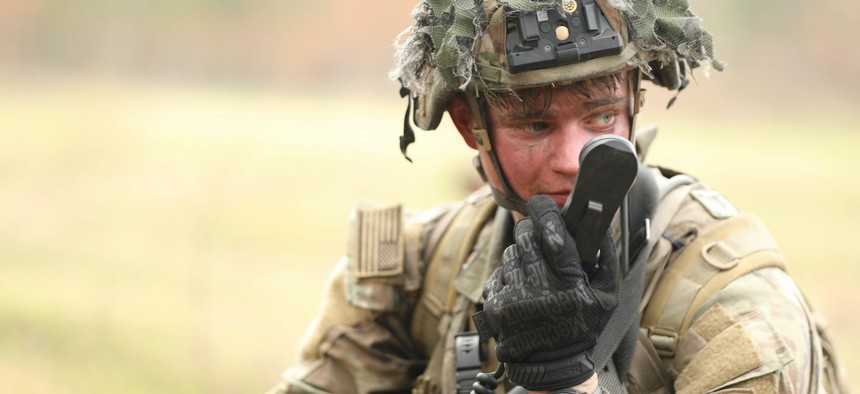
Soldiers from the 2nd Brigade Combat Team face off with "Geronimo" at the Joint Readiness Training Center at Ft. Johnson, Louisiana, in 2023. U.S. Army / Pfc. Mason Nichols
How one Army unit uses cheap drones and ChatGPT to train others in modern warfare
Some lessons are basic: don’t name your field HQ’s WiFi “command post.”
FORT JOHNSON, Louisiana—Army units learn fast that their cell phone signals stand out amid the vast, unpopulated pine forests of the Joint Readiness Training Center here.
The lesson is usually delivered when they are “killed” by the force playing their opposition, known as Geronimo, which uses cheap, commercial technology to target unwary soldiers. It’s a lesson U.S. forces should learn, says the Army’s chief of staff.
Inexpensive technology can be “very, very effective,” Gen. Randy George said in an interview at the center.
George cited a $75 decoy device built by Geronimo that mimics the electromagnetic signature of a command post. But that’s just the tip of the Geronimo’s home-built arsenal, which includes everything from computer code written by ChatGPT to a thermal-scoped, bomb-dropping version of the Army’s TS-M800 quadcopter.
The unit is not yet authorized to use FPV drones, commonly used as one-way attack drones in Ukraine, said chief warrant officer Christian Lehr, although he said he’s studied their use in Ukraine.
But Geronimo’s modified quadcopters can do plenty already. One TS-M800 carries scanners that can find cell and WiFi signals. By flying drones over the forest, Geronimo members told George on Monday, they could identify Army positions by picking up WiFI signals below.
In one case, an Army unit made Geronimo’s job even easier: they labeled their command post WiFi “command post.”
Even if an Army unit does mask itself well, a few slip-ups can quickly reveal its location or identity. In one instance, Lehr said, Geronimo noticed communication between different MAC addresses — unique identifiers used by networked devices.
They used ChatGPT to create software in the coding language Python that analyzed communication between MAC addresses. Based on their movement and communication patterns, Geronimo could deduce what types of units they were tracking.
“It's just a simple visualization tool; this is not Skynet,” Lehr said.
Such tools may be less secure than U.S. Army software, Lehr said. Still, commercial software can sometimes be the better option if it defeats an enemy before they can exploit a vulnerability.
“I don't care if you can hack into my stuff if you're dead,” he said.
Lehr also highlighted Geronimo’s use of cheap hardware like the Raspberry Pi hobbyist computer and spectrum-analysis devices like HackRF and RTL-SDR. Such devices are widely used in Ukraine to identify enemy drones.
Geronimo’s use of commercially available, open-source compatible technology also tamps down logistics burdens, he said.
“I would rather have an 80 percent solution that works 90 percent of the time than a Swiss Army knife that may or may not solve all my problems in a large-scale combat operations environment that’s not rapidly replaceable and that’s incredibly expensive to maintain,” Lehr said.
Geronimo’s use of drone bombers can be so effective that other units sometimes think the unit is cheating, Lehr said.
In one instance, Geronimo’s TS-M800 drone bomber acquired and attacked a target in 45 seconds, said Lehr. The speed was made possible in part by having a drone operator, intelligence officer, and artillery non-commissioned officer working side by side.
But the units that Geronimo is facing are learning to fight fire with fire.
On an upcoming rotation to the training center, units from the Third Infantry Division will once again test a device that mimics the electromagnetic signature of a company or battalion command post, Army Capt. Chris Flournoy told Defense One.
Flournoy said the devices may be transported from place to place by drone or an unmanned ground vehicle.
Units are also getting better at integrating technology into battle, said Geronimo Capt. Sean Murphy.
In one engagement, Geronimo forces gathered for an assault on an Army unit. As the Geronimo soldiers moved forward, their would-be prey followed them with small drones and engaged them, eventually piling on everything from mortars to artillery. Murphy believes his team was initially spotted and identified with electromagnetic sensors.
“Units are getting better at combined arms maneuver,” he said, referring to the coordination between infantry, artillery, and other types of units. “We were completely destroyed.”




